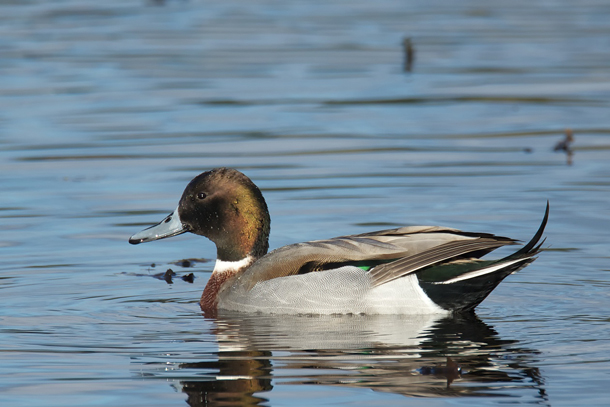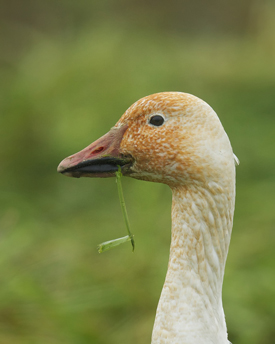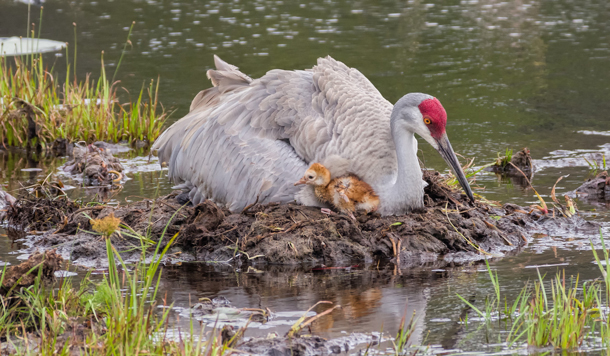BirdNote®: The Rainwater Basin of Nebraska
Air Date: Week of March 29, 2019

A hybrid mallard/pintail. (Photo: Gregg Thompson)
Spring rains bring out the green and help water crops. And in south-central Nebraska, they provide watering grounds for migrating birds including the Sandhill Cranes. BirdNote®’s Michael Stein has more.
Transcript
BASCOMB: About 200 miles west of the devastating flooding in Nebraska is the Rainwater Basin wetland. It’s 6200 square miles of depressions left by retreating glaciers that fill with rain and snowmelt each spring. As BirdNote’s Michael Stein explains it’s a crucial habitat for migratory waterfowl making their way north this time of year.
[NORTHERN PINTAILS SPLASHING IN WATER]

An adult snow goose (Photo: Gregg Thompson)
STEIN: For 20,000 years, spring rains and melting snow have filled the playas of the Rainwater Basin of south-central Nebraska. Carved by glacial winds at the end of the last Ice Age, the playas are shallow depressions the warmth of spring fills with abundant life.
[RED-WINGED BLACKBIRDS]
STEIN: As winter ends, ten million waterfowl rest and feed here before continuing north.
[CALLS OF NORTHERN PINTAILS, BLUE-WINGED TEAL WITH MALLARDS AND MARSH SOUNDS]
STEIN: The seasonal wetlands of the Rainwater Basin form a 150-mile-wide funnel for water birds migrating from the Gulf Coast and points south to northern breeding grounds. The basin is the narrowest neck of the great migratory route we call the Central Flyway.
[CALLS OF SNOW GEESE]
STEIN: In recent years, the number of Snow Geese stopping in the region during spring has risen dramatically to more than three million birds. A third of North America’s Northern Pintails rely on the food-rich habitat here.
[CALLS OF NORTHERN PINTAILS]
STEIN: Shorebirds of 27 species use the wetlands. So do half a million Sandhill Cranes.

A sandhill crane and her chick (Photo: Larry Crovo, Flickr, CC BY-ND 2.0)
[CALLS OF SANDHILL CRANES]
STEIN: The importance of the region’s wetlands for waterfowl cannot be overstated. Fat reserves acquired during their stay here can mean the difference between success and failure in nesting. No other stopover between wintering and nesting grounds can replace the combination of wetlands and grain fields found in the Rainwater Basin.
[CALLS OF SANDHILL CRANES]
STEIN: I’m Michael Stein.
BASCOMB: For photos of the Rainwater Basin’s migrating birds splash on over to our website, LOE dot ORG.
Links
Living on Earth wants to hear from you!
Living on Earth
62 Calef Highway, Suite 212
Lee, NH 03861
Telephone: 617-287-4121
E-mail: comments@loe.org
Newsletter [Click here]
Donate to Living on Earth!
Living on Earth is an independent media program and relies entirely on contributions from listeners and institutions supporting public service. Please donate now to preserve an independent environmental voice.
NewsletterLiving on Earth offers a weekly delivery of the show's rundown to your mailbox. Sign up for our newsletter today!
 Sailors For The Sea: Be the change you want to sea.
Sailors For The Sea: Be the change you want to sea.
 The Grantham Foundation for the Protection of the Environment: Committed to protecting and improving the health of the global environment.
The Grantham Foundation for the Protection of the Environment: Committed to protecting and improving the health of the global environment.
 Contribute to Living on Earth and receive, as our gift to you, an archival print of one of Mark Seth Lender's extraordinary wildlife photographs. Follow the link to see Mark's current collection of photographs.
Contribute to Living on Earth and receive, as our gift to you, an archival print of one of Mark Seth Lender's extraordinary wildlife photographs. Follow the link to see Mark's current collection of photographs.
 Buy a signed copy of Mark Seth Lender's book Smeagull the Seagull & support Living on Earth
Buy a signed copy of Mark Seth Lender's book Smeagull the Seagull & support Living on Earth

